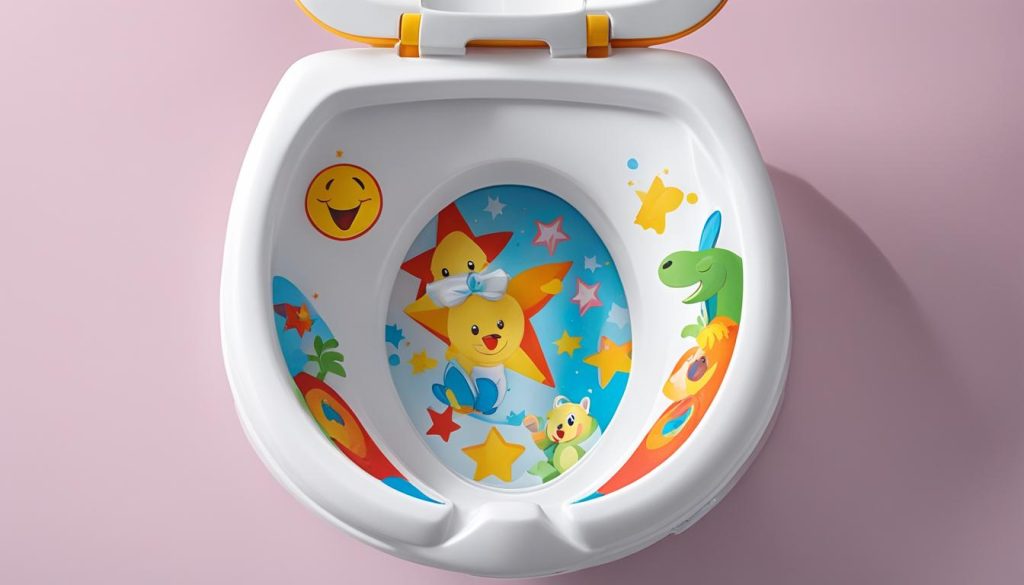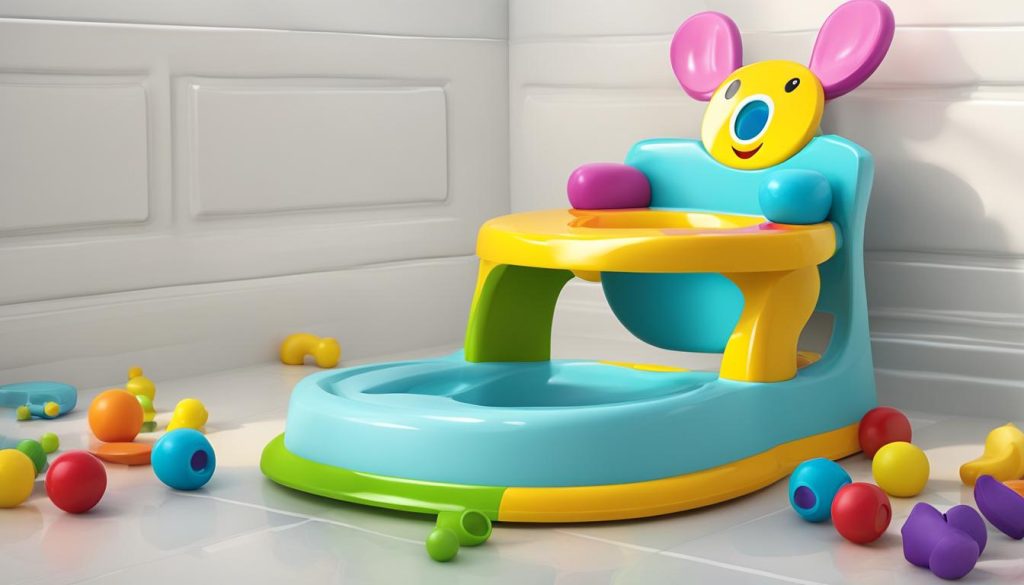Welcome to my comprehensive guide on how to use a baby potty seat effectively. In this article, I will provide you with valuable potty training tips and instructions to help you navigate the toddler toilet training process. Whether you’re a first-time parent or looking to improve your potty training techniques, this guide will provide you with the knowledge you need.
Potty training can be a challenging time for both parents and children. However, using a baby potty seat can make this process easier and more manageable. In this guide, we’ll cover everything from different types of potty seats to practical tips for choosing the right one for your child. So let’s dive in and explore how to use a baby potty seat effectively!
Different Designs and Features of Potty Seats
When it comes to potty seats, there are various designs and features available to choose from, catering to the different needs and preferences of children. These designs not only provide comfort but also promote independence and ease of use for both parents and toddlers.
Potty Seats with Handles
One popular design feature of potty seats is the inclusion of handles. These handles offer added security and stability for children, giving them a sense of confidence while seated. The handles provide a firm grip for little hands, minimizing the risk of slips or accidents during the potty training process.
Padded Potty Seats
Padded potty seats are designed with extra cushioning to ensure maximum comfort for your child. The soft padding provides a cozy and comfortable seat, making potty time a more pleasant experience. These seats are especially beneficial for children who may have sensitive skin or those who require additional comfort during longer periods of sitting.
Flip-Up Seats
Flip-up seats are a convenient design option that saves time and effort for parents. These seats can be permanently attached to the toilet, allowing for easy and quick access whenever needed. The flip-up mechanism enables the seat to stay securely in place when not in use, eliminating the need to repeatedly position the seat onto the toilet.
Seats with Built-in Steps
For children who are ready to transition to using the regular toilet independently, potty seats with built-in steps are an excellent choice. These seats typically have a sturdy ladder-like structure with steps, allowing children to climb up and use the toilet with ease. The built-in steps provide the necessary support and stability for children, encouraging self-sufficiency.
By considering these different designs and features, parents can choose a potty seat that best suits their child’s needs and preferences. Whether it’s the added security of handles, the comfort of padded seats, the convenience of flip-up seats, or the independence provided by seats with built-in steps, there is a potty seat available to make the potty training journey smoother and more enjoyable for both parent and child.
Practical Tips for Choosing the Right Potty Seat
Welcome to section 3 of our comprehensive guide on how to use a baby potty seat effectively. In this section, I will provide you with practical tips on choosing the right potty seat for your little one. When it comes to introducing a potty seat to your baby, it’s important to consider their preferences and needs. Let’s dive in!
First and foremost, involving your baby in the decision-making process can make a significant difference. By allowing them to participate in choosing their potty seat, you’ll increase their interest and motivation to use it. This can be as simple as showing them different designs or colors and asking for their input.
Stability is another crucial factor to consider. A wobbly potty seat can be intimidating for a baby, making them less confident in using it. Ensure that the potty seat you choose is stable and secure. Additionally, consider using a stool to provide support for your baby’s feet, as this can enhance their overall comfort and stability during potty training.
When it comes to practicality, opt for a potty seat that is easy to use and clean. Look for features such as a removable pot or a splash guard that can prevent messes. Portable options can also be convenient, especially if you plan on traveling or using the potty seat in different bathrooms.
To summarize, involving your baby in the decision-making process, prioritizing stability, and choosing a potty seat that is easy to use and clean are essential aspects of finding the right potty seat. By following these practical tips, you’ll be well on your way to a successful potty training journey. Stay tuned for the next section where I’ll share important tips on ensuring comfort and safety for your child.
Ensuring Comfort and Safety for Your Child
When it comes to using a baby potty seat, ensuring your child’s comfort and safety is of utmost importance. By choosing the right features and design, you can create a positive and supportive environment for your child’s potty training journey. Here are some tips to help you prioritize comfort and safety:
Choose an Ergonomically Designed Seat
Look for potty seats that are ergonomically designed to provide maximum comfort for your child. These seats are specifically crafted to support your child’s body and promote proper posture during potty training.
Opt for Padded Seats and Seats with Handles
Padded potty seats offer extra comfort, providing a soft and cushioned surface for your child to sit on. Seats with handles offer added security, giving your child a sense of stability while using the seat.
Consider Extra-Stable Chairs for Special Needs Children
If your child has special needs, it’s important to choose a potty seat that provides extra stability. Look for chairs with seatbelts to ensure their safety during the potty training process. These chairs are designed to accommodate special requirements and provide a secure and supportive environment.
Use a Step Stool
A step stool can be a valuable addition to your potty training setup. It helps your child feel more secure by providing a stable platform to step onto when using the potty seat. This simple tool can make your child’s experience more comfortable and promote independence.
By prioritizing comfort and safety, you can create a nurturing and supportive environment for your child’s potty training journey. Remember to choose a seat that is ergonomically designed, consider padded seats and seats with handles, opt for extra-stable chairs for special needs children, and use a step stool for added support. These measures will ensure that your child feels comfortable and secure during the potty training process.
Tips for Using a Baby Potty Seat Effectively
To ensure successful potty training using a baby potty seat, it’s important to follow a step-by-step approach. By implementing these practical tips, you can help your child become familiar with the potty training process and develop the skills necessary for independent toilet use.
Establish a Routine
Creating a consistent potty training routine is key to your child’s success. Encourage them to sit on the potty chair or toilet seat regularly throughout the day, even if they don’t need to go. This helps them become accustomed to the potty seat and builds a habit. Consistency is key in reinforcing the concept of using the potty seat as a part of their daily routine.
Respond Promptly to Signs of Need
When your child exhibits signs that they need to use the toilet, such as squirming or holding their diaper, respond promptly. Guide them to the potty seat and encourage them to sit and try. Even if they don’t immediately succeed, praise their efforts and provide positive reinforcement. This will motivate them to continue trying and build their confidence.
Transition to Training Pants or Underwear
As your child shows consistent success in using the potty seat, gradually transition them from diapers to training pants or underwear. This signals a shift towards independence and reinforces the notion that using the potty seat is how “big kids” go to the bathroom. Be patient during this transition phase and provide support as needed.
Remember, every child is unique and may progress at their own pace. It’s important to create a supportive and encouraging environment throughout the potty training journey. By following these tips and remaining patient, you can help your child successfully master the use of a baby potty seat and achieve a significant milestone in their development.
Conclusion
Potty training is an important milestone for young children, and using a baby potty seat can aid in the process. By considering the different designs and features available, involving your child in the decision-making process, prioritizing comfort and safety, and following effective tips, you can successfully navigate the potty training journey.
Remember that every child is unique, and the key to success lies in understanding your child’s readiness and providing a supportive and encouraging environment. By following these steps, you can help your child develop the necessary skills and confidence to become independent in using the potty.
Remember that potty training takes time and patience, so don’t be discouraged if there are setbacks along the way. With consistency and positive reinforcement, your child will eventually master this important life skill. Best of luck on your potty training journey!
Source Links
- https://www.pull-ups.com/en-us/resources/tips-advice/how-to-potty-train/potty-training-seat
- https://www.parents.com/toddlers-preschoolers/potty-training/basics/step-by-step-guide-to-potty-training/
- https://www.mayoclinic.org/healthy-lifestyle/infant-and-toddler-health/in-depth/potty-training/art-20045230





